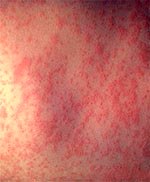Science Seen Physicist and Time One author Colin Gillespie helps you understand your world.
Many Measly Ways of Dying
A new study has revealed how infection with measles exposes children to many other causes of death. This is something caring parents need to know about.
 Measles (aka rubeola) shows up as a rash. It is very infectious. Because it mostly just goes away we tend to think of it as a nuisance that keeps kids out of school for days. But measles does occasionally kill or cause bad complications. So I (like others) say that everyone who can get vaccinated should get vaccinated both for self-protection and to protect those—such as cancer patients—who cannot get vaccinated and for whom an infection can be much worse.
Measles (aka rubeola) shows up as a rash. It is very infectious. Because it mostly just goes away we tend to think of it as a nuisance that keeps kids out of school for days. But measles does occasionally kill or cause bad complications. So I (like others) say that everyone who can get vaccinated should get vaccinated both for self-protection and to protect those—such as cancer patients—who cannot get vaccinated and for whom an infection can be much worse.
Now a new US/European study, using data from the USA, UK and Denmark, finds an unsuspected and far wider danger lurking in measles infections in all three countries. After catching the measles, the death rate from all other infectious diseases doubles. This doubled death rate lasts for years!
To understand this strange effect, we need to focus on the way our immune system protects us from infections. On our first exposure to any bug, our immune system doesn’t give us much protection. But it learns from that exposure. It keeps records of the bugs it has encountered. On our next exposure to that bug our immune system recognizes it and attacks it quickly. Usually this helps us to kill off the bug before it can gain a foothold in our body, so to speak.
And here’s the key: Our body keeps its bug-records in special memory cells (called lymphocytes). Our memory cells can recognize a lot of common bugs. That is, they can until we catch the measles. Recent studies show a measles infection knocks out most of the patient’s memory cells. Though they grow back within weeks, the latest research shows that the new memory cells have forgotten all the patient’s past exposures to those common bugs. They recognize the measles and nothing but the measles. As the authors say (in tech-speak):
Measles virus infection replaced the previous memory cell repertoire with measles-virus-specific lymphocytes, resulting in “immune amnesia” to non-measles pathogens.
Almost all measles patients get well, with no rash and seemingly no lasting problems. But their defences are down. Unaware, these patients are open to a host of common infections. The new study says that their exposed condition lasts for years. Throughout those years their chances of dying from some other bug are doubled. Measles vaccination does not directly protect against infection by those other bugs. But it does do a good job of preventing measles infection. We now know that it also does a good job of preserving our immune system’s bug-records. And so it protects us against that measly increase in the death rate from other infections.
Parents naturally want to get good information about how best to protect their children. In a recent post (Taking the Shot) I looked at how the risks of getting vaccinated against common infectious diseases such as measles are much lower than the risks of not getting vaccinated. I said too that vaccination is a duty that we owe each other because it protects not only us but everybody we might otherwise infect. To which we may now add: Measles vaccination saves a lot more children from a lot more kinds of infection—and so saves a lot more lives—than we previously thought.
Sources:
Michael Mina et al (2015), “Long-term measles-induced immunomodulation increases overall childhood infectious disease mortality”, Science, Washington: AAAS, vol. 348, p. 649; http://www.sciencemag.org/content/348/6235/694.full
Image credit: Centers for Disease Control and Prevention, http://www.cdc.gov/measles/about/signs-symptoms.html

No comments yet.